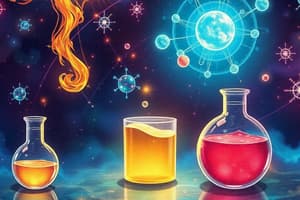Podcast
Questions and Answers
What is the primary purpose of a titration?
What is the primary purpose of a titration?
- To measure the volume of a solution.
- To form spectator ions.
- To create a stock solution.
- To determine the concentration of an unknown solution. (correct)
Which process describes the formation of ions from neutral molecules when dissolved in water, such as with acids?
Which process describes the formation of ions from neutral molecules when dissolved in water, such as with acids?
- Ionization (correct)
- Precipitation
- Standardization
- Dissociation
What characteristic defines spectator ions in a chemical reaction?
What characteristic defines spectator ions in a chemical reaction?
- They precipitate out of the solution.
- They remain unchanged and are present on both sides of the equation. (correct)
- They are involved directly in the reaction.
- They are formed during the reaction.
What type of solution is prepared with a precise concentration and typically made in a volumetric flask?
What type of solution is prepared with a precise concentration and typically made in a volumetric flask?
A concentrated solution that needs to be diluted before use is best described as a:
A concentrated solution that needs to be diluted before use is best described as a:
Flashcards
Titration
Titration
A procedure used to determine the concentration of a solution by reacting it with a solution of known concentration.
Dissociation
Dissociation
The splitting of an ionic compound into its ions when dissolved in water.
Ionization
Ionization
The formation of ions from uncharged molecules when dissolved in water.
Spectator Ions
Spectator Ions
Signup and view all the flashcards
Standard Solution
Standard Solution
Signup and view all the flashcards
Study Notes
SNC3U1 Exam Review
- Titration: A procedure used to determine the concentration of a solution using a standardized solution (known concentration). (Section 10.3)
- Dissociation: The separation of ions when an ionic compound dissolves in water.
- Ionization: Formation of ions from uncharged molecules (non-electrolytes) when in water (e.g., acids). (Section 10.2)
- Spectator Ions: Ions that appear on both sides of a chemical equation, remain unchanged, and can be omitted to simplify the net ionic equation. (Section 9.1)
- Standard Solution: A solution with a precisely known concentration, typically prepared using a volumetric flask. (Section 8.6)
- Stock Solution: A concentrated solution that is diluted to a lower concentration before use. (Section 8.6)
- Polar Bonds: Covalent bonds where electrons are not shared equally due to differences in electronegativity (0.5 < EN < 1.7)
- Non-Polar Bonds: Covalent bonds where electrons are shared equally (0 < EN < 0.5)
- Ionic Bonds: Very strong bonds resulting from a complete transfer of electrons (EN > 1.7). High melting points.
- Precipitate: A solid formed from a chemical reaction in a solution.
- Dipole-Dipole Forces: Relatively strong intermolecular forces between polar molecules. The polarity is stronger when the EN difference is greater.
- London Dispersion Forces: Weak attractive forces between all molecules (polar or nonpolar). Temporary fluctuations in electron distribution cause temporary dipoles.
- Hydrogen Bonding: A type of dipole-dipole force. Strong bond between a hydrogen atom bonded to a highly electronegative atom (N, O, F) and another electronegative atom in a different molecule.
- Theoretical Yield: The predicted amount of product based on the balanced chemical equation.
- Actual Yield: The amount of product actually obtained in an experiment.
- Percentage Yield: (Actual Yield/Theoretical Yield) x 100%
- Chemical Change: Observable changes like color change, energy release/absorption, gas production, or precipitate formation.
- Unsaturated Solution: A solution that can dissolve more solute at a given temperature.
- Saturated Solution: A solution that contains the maximum amount of solute that can be dissolved at a given temperature.
- Supersaturated Solution: A solution containing more solute than it can hold at a given temperature. This is unstable, and small changes can lead to crystallization.
Additional Concepts (from page 2)
- Periodic Table Groups: Groups (columns) of elements with similar chemical properties are labeled 1-18.
- Periodic Table Periods: Periods (rows) show trends in elemental properties.
- Charles' Law: The volume of a gas is directly proportional to its temperature (in Kelvin) at constant pressure. (V1/T1 = V2/T2)
- How to create Super Saturated Solution: Heat the solution to saturation point (dissolve maximal solute). Cool back slowly, allowing solute to remain in solution beyond the max amount.
Additional Concepts (From page 3)
- Boyles' Law: The volume of a gas is inversely proportional to its pressure at constant temperature. (P1V1 = P2V2)
- Gay-Lussac's Law: The pressure of a gas is directly proportional to its temperature (in Kelvin) at constant volume. (P1/T1 = P2/T2)
- Combined Gas Law: Combines Boyle's, Charles', and Gay-Lussac's laws. (P1V1/T1 = P2V2/T2)
- Dalton's Law of Partial Pressures: The total pressure of a mixture of non-reacting gases is the sum of the partial pressures of the individual gases. (Ptotal = P1 + P2 + ... )
- Avogadro's Law: Equal volumes of gases at the same temperature and pressure contain the same number of molecules.
- Effective Nuclear Charge: The net positive charge experienced by an electron in an atom, taking into account the shielding effect of inner electrons.
- Electron Shielding: Inner electrons reduce the attractive force between the nucleus and outer electrons.
- Alkali Metals: Group 1 elements, highly reactive, soft metals.
- Alkaline Earth Metals: Group 2 elements, reactive metals.
- Transition Metals: Elements in groups 3-12 with diverse properties, typically good conductors of electricity and heat, and have high melting/boiling points.
- Metalloids: Staircase elements displaying properties of both metals and nonmetals.
Additional Concepts (from page 4)
- Oxyanion: A negatively charged polyatomic ion containing oxygen. Examples include carbonate (CO3⁻²) and sulfate (SO₄⁻²).
- Electron Configuration: Shows the arrangement of electrons in different orbitals around the nucleus of an atom. Used in predicting chemical behavior.
- Lewis Structures: Diagrams showing the arrangement of atoms and valence electrons in a molecule.
Additional Concepts (from page 5)
- VSEPR (Valence Shell Electron Pair Repulsion): Theory used to predict the 3D shape of molecules based on the repulsion between electron pairs.
- Isotope Calculations: Used to determine average atomic mass (weighted average) of an element.
- Electronegativity: The ability of an atom to attract electrons in a chemical bond.
- Atomic Size: Atomic size generally increases down a group and decreases across a period of the periodic table.
Additional Concepts (from page 6)
- Empirical Formula: The simplest whole-number ratio of atoms in a compound.
- Molecular Formula: Represents the actual number of atoms of each element in a molecule of a compound.
Additional Concepts (from page 7)
- Calculating Empirical and Molecular Formulas: Steps involved in determining these formulas based on percent composition or mass data. This often includes converting to moles and then using ratios to obtain the lowest common multiple in a whole number ratio.
Studying That Suits You
Use AI to generate personalized quizzes and flashcards to suit your learning preferences.




